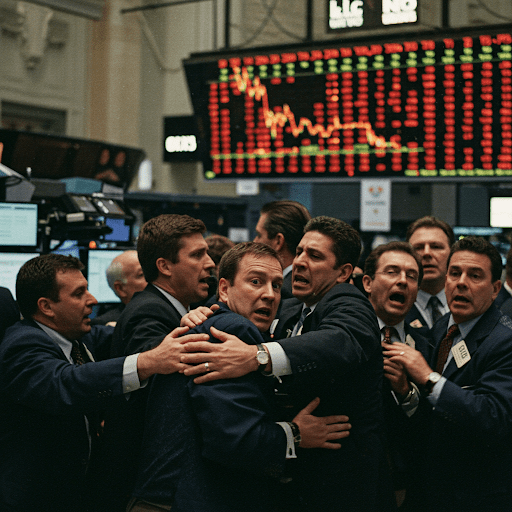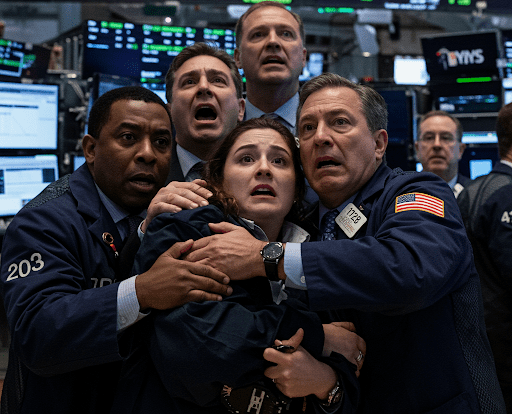Feeling a bit jittery about the market lately? Seeing headlines about tariffs, tech stocks doing the cha-cha, or maybe just the general vibe of gestures vaguely at everything? It’s easy to feel like the sky is falling, especially when your portfolio looks like it went a few rounds with a heavyweight champ.
But here’s the thing: market mayhem isn’t exactly a new invention. Investors have been collectively freaking out for centuries. Let’s take a quick trip back to the 1630s Netherlands, shall we?
When Flowers Cost More Than Furniture (and Houses)
Imagine this: Tulips, newly arrived from Turkey, become the hottest status symbol. Owning them? Chef’s kiss. Then, some tulips catch a virus – mosaic – which, instead of killing them, makes their petals look like groovy tie-dye. Suddenly, these “broken bulbs” are the rarest, most desirable things ever.

Prices didn’t just rise; they went ballistic. We’re talking people trading their life savings, their land, maybe even their prized wooden clogs, for a single bulb. At the peak, one fancy tulip bulb could cost more than a swanky Amsterdam canal house. People bought bulbs on credit, convinced they’d sell them to some other sucker—er, investor—for even more. They even invented futures contracts, basically gambling on tulip prices without ever touching a petal.
Then, in February 1637… pop. Confidence evaporated faster than free beer. Everyone rushed to sell, but the buyers had vanished. Prices crashed, fortunes were lost, and a lot of people were left holding very expensive onions. Tulip Mania: a classic tale of greed, hype, and the danger of believing flowers are a solid retirement plan.
Modern Mayhem: Faster, But Still Familiar
So, have we learned our lesson? Well, yes and no. We still have crashes, they just happen faster now, thanks to the internet and computers that trade faster than we can blink.
- The COVID Crash (2020): Remember early 2020? The pandemic hit, and markets plunged faster than ever before. Pure, unadulterated panic. But then, governments and central banks unleashed unprecedented amounts of support (think giant money hoses). Markets bounced back surprisingly quickly, even while the rest of the world was hoarding toilet paper.
- The Inflation Hangover (2022): All that support money, combined with supply chain chaos and other factors, led to inflation roaring back like it was the 1970s. Central banks, especially the Fed, slammed on the brakes, hiking interest rates aggressively. This hurt. Badly. Not only did stocks tank, but bonds (usually the safe harbor) also got hammered. It was a rough year for the classic “balanced” portfolio.
- Ongoing Jitters: Even without a full-blown crash, we see plenty of volatility. Tech stocks, especially the big names, get shaky when faced with new competition (like cheaper AI rivals) or tariff threats. Cryptocurrencies like Bitcoin remain the Wild West, capable of huge swings based on news, regulation, or just plain old speculation. Sometimes, boring old stocks are actually less volatile than Bitcoin, which tells you something. And let’s not forget the background noise of trade wars, geopolitical tensions, and wondering what the Fed will do next.

Same Story, Different Century?
Comparing Tulip Mania to today shows some things never change:
- Human Psychology: Greed and Fear of Missing Out (FOMO) are timeless drivers of bubbles. Panic is panic, whether you’re selling tulips or tech stocks.
- Innovation Hype: New, exciting things (rare tulips, the internet, AI, crypto) are hard to value, making them ripe for speculation.
- Leverage Amplifies Everything: Borrowing money to invest makes the ups bigger and the downs much bigger.
But there are differences:
- Speed: Today’s markets move at lightning speed.
- Policy Intervention: Modern governments and central banks step in much more forcefully than they did in 1637 (though whether that’s always good long-term is debatable).
Your Not-So-Secret Weapon: Diversification
So, if volatility is basically guaranteed, how do you survive without developing a permanent eye twitch? The oldest, most boring, yet most effective advice is still diversification.
Think of it like this: don’t put all your eggs in one basket. Spread your investments across different things that hopefully won’t all crash at the same time :
- Different asset classes (stocks, bonds, maybe real estate, etc.)
- Different regions (US, international, emerging markets)
- Different industries (tech, healthcare, energy, boring stuff)
The goal isn’t to hit home runs every time, but to avoid striking out completely. When one part of your portfolio zigs, another might zag, smoothing out the ride.
Did it work recently? Well, in 2020, bonds eventually helped stabilize things after the initial shock. In 2022, when almost everything fell, a diversified portfolio probably still lost less than one loaded up only on, say, tech stocks. It’s not a magic shield, but it reduces the risk of one bad sector or event torpedoing your entire future.
Nowadays, things like ETFs and mutual funds make diversification easy. Just remember it’s not “set and forget.” You need to rebalance occasionally to keep your mix right, especially after big market moves.
The Takeaway
Market crashes are scary, sometimes weird (tulips!), but they happen. Panicking and selling at the bottom is usually the worst thing you can do. History shows markets eventually recover. Stay calm, remember the Dutch guy who traded his house for a flower, keep your portfolio diversified, and try to focus on your long-term goals. It might not be exciting, but it’s the best way to sleep at night (or at least, sleep slightly better).











+ There are no comments
Add yours